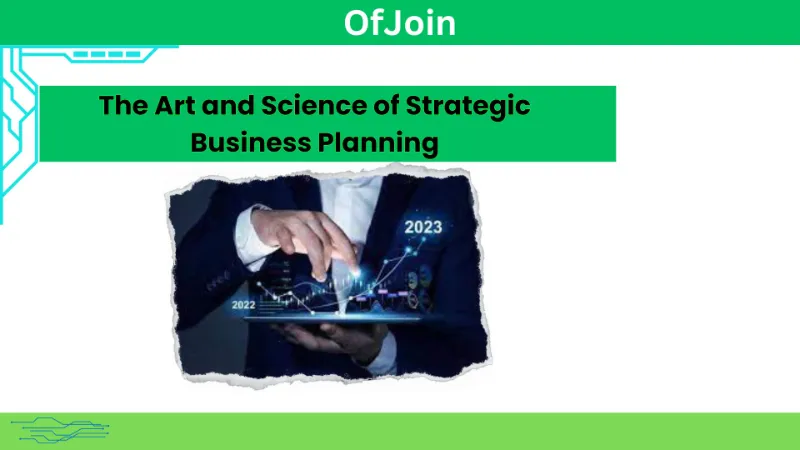Navigating Success: The Art and Science of Strategic Business Planning
Introduction:
In the dynamic landscape of modern business, where change is constant and competition is fierce, strategic business planning stands as a guiding compass for organizations seeking sustainable growth and success. Far more than a routine administrative task, strategic business planning is a comprehensive process that aligns a company’s goals, resources, and actions to navigate the challenges and opportunities in its environment. In this detailed exploration, we delve into the intricacies of strategic business planning, examining its importance, key components, and the role it plays in fostering resilience and innovation.
Understanding Strategic Business Planning:
1. Defining the Essence:
At its core, strategic business planning is about setting a clear direction for an organization and making decisions on allocating its resources to pursue this direction. It involves defining goals, understanding the competitive landscape, and crafting a roadmap that guides the company towards its envisioned future. The strategic plan becomes a blueprint that informs day-to-day operations and decision-making.
2. Long-term Vision vs. Short-term Goals:
Strategic business planning distinguishes between long-term vision and short-term goals. While a long-term vision provides a sense of purpose and direction, short-term goals break down the journey into manageable steps. Striking the right balance is crucial, ensuring that immediate objectives contribute to the realization of the overarching vision.
Key Components of Strategic Business Planning:
1. SWOT Analysis:
A robust strategic plan begins with a thorough analysis of the organization’s strengths, weaknesses, opportunities, and threats (SWOT). Understanding internal capabilities and external factors provides a foundation for informed decision-making. This analysis serves as a diagnostic tool, revealing areas for improvement and avenues for growth.
2. Setting SMART Goals:
Goals in strategic planning should be Specific, Measurable, Achievable, Relevant, and Time-bound (SMART). This ensures that objectives are well-defined, quantifiable, realistic, aligned with the organization’s mission, and have a clear timeframe for achievement. SMART goals provide a framework for evaluating progress and success.
3. Environmental Scan:
Conducting a comprehensive environmental scan involves assessing the external factors that can impact the organization, including economic trends, market dynamics, technological advancements, and regulatory changes. This helps in anticipating challenges and identifying opportunities, allowing the organization to proactively position itself in the market.
4. Resource Allocation:
Effective strategic planning involves allocating resources judiciously. This includes financial resources, human capital, and technological infrastructure. Prioritizing investments based on strategic priorities ensures that resources are optimized and directed toward activities that align with the organization’s goals.
5. Risk Management:
Strategic planning is not without its uncertainties, and effective plans incorporate risk management strategies. Identifying potential risks, assessing their impact, and developing mitigation plans contribute to organizational resilience. A proactive approach to risk management enhances the organization’s ability to adapt to unforeseen challenges.
6. Monitoring and Evaluation:
A strategic plan is a living document that requires continuous monitoring and evaluation. Regular reviews assess the progress of initiatives, identify deviations from the plan, and provide an opportunity for course correction. Flexibility is key, allowing organizations to adapt their strategies based on evolving circumstances.
The Importance of Strategic Business Planning:
1. Direction and Focus:
Strategic business planning provides a clear sense of direction for the organization. It helps leadership and employees understand the overarching vision and the specific steps required to achieve it. This clarity fosters a sense of purpose and ensures that efforts are aligned towards common objectives.
2. Resource Optimization:
By identifying priorities and allocating resources strategically, organizations can optimize their operations. This includes financial investments, human resources, and time. The result is a more efficient and effective use of resources, contributing to improved performance and competitiveness.
3. Adaptability to Change:
In a rapidly changing business environment, adaptability is a critical factor for success. Strategic planning equips organizations with the foresight to anticipate changes, whether in market conditions, technological advancements, or regulatory landscapes. This proactive approach enhances the organization’s ability to navigate change successfully.
4. Innovation and Growth:
Strategic planning fosters an environment conducive to innovation. By setting ambitious yet achievable goals, organizations encourage a culture of creativity and continuous improvement. The pursuit of strategic objectives often involves exploring new markets, developing innovative products, and embracing emerging technologies, driving overall growth.
5. Enhanced Decision-making:
Well-defined goals and a clear roadmap streamline decision-making processes within the organization. With a strategic plan as a reference point, leaders can make informed decisions that align with the long-term vision. This reduces ambiguity and ensures that choices contribute to the organization’s overall success.
Challenges in Strategic Business Planning:
1. Balancing Short-term and Long-term Objectives:
Finding the right equilibrium between short-term gains and long-term vision can be challenging. Pressures to meet immediate targets may sometimes conflict with the need to invest in strategies that ensure sustained success over the long term.
2. Adapting to Rapid Changes:
In dynamic industries and markets, rapid changes can outpace the strategic planning process. Organizations need to cultivate agility and flexibility to adapt their plans swiftly in response to unforeseen developments.
3. Aligning Stakeholder Expectations:
Stakeholders, including employees, investors, and customers, may have divergent expectations. Successful strategic planning requires effective communication to align stakeholders and garner their support for the organization’s goals.
4. Integration with Organizational Culture:
Strategic planning is most effective when it aligns with the organization’s culture. Introducing new strategies that clash with existing cultural norms can lead to resistance. Successful integration involves a careful balance between innovation and preservation of core organizational values.
Case Studies: Successful Implementations of Strategic Business Planning:
1. Apple Inc.:
Apple’s success can be attributed, in part, to its strategic planning prowess. The company’s focus on innovation, customer experience, and ecosystem integration aligns with its long-term vision. Apple’s strategic decisions, such as the introduction of iconic products and the creation of a seamless user experience, have contributed to its sustained growth and market dominance.
2. Amazon:
Amazon’s strategic planning is exemplified by its customer-centric approach, relentless innovation, and diversification of services. The company’s expansion from an online bookstore to a global e-commerce giant, cloud services provider, and entertainment producer showcases a well-executed strategic plan that continuously adapts to changing market dynamics.
3. Tesla:
Tesla’s strategic planning revolves around the vision of sustainable transportation and energy. The company’s success in the electric vehicle market, coupled with advancements in renewable energy solutions, underscores a strategic approach that aligns with societal and environmental trends.
Conclusion:
Strategic business planning is the
compass that guides organizations through the complexities of the business landscape. It is an iterative process that requires continuous assessment, adaptation, and a keen understanding of internal and external dynamics. While challenges exist, the benefits of strategic planning are undeniable. Organizations that embrace this process are better equipped to navigate uncertainties, capitalize on opportunities, and chart a course toward sustained success. As technology, markets, and consumer expectations evolve, strategic business planning remains a foundational practice for those aiming not only to survive but to thrive in the ever-changing world of business.







